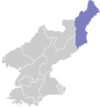Kyonghung County
| Kyonghung County 경흥군 | |
|---|---|
| County | |
| Korean transcription(s) | |
| • Hanja | 慶興郡 |
| • McCune-Reischauer | Kyŏnghŭng-gun |
| • Revised Romanization | Gyeongheung-gun |
| Country | North Korea |
| Province | North Hamgyong Province |
| Administrative divisions | 1 ŭp;, 3 workers' districts, 12 ri |
| Area | |
| • Total | 920 km2 (360 sq mi) |
| Population (1991 est.) | |
| • Total | 100,000 |
Kyŏnghŭng County is a kun, or county, in North Hamgyong province, North Korea. Formerly known as Ŭndŏk County (Chosŏn'gŭl: 은덕군; Hancha: 恩德郡), from 1977 to 2010.
The county borders the People's Republic of China to the northeast. With the exception of the southwest, it is dominated by low hills, with occasional plains. The highest point is Songjinsan (1,146 m (3,760 ft)). The dominant river is the Tumen, which separates the county from China. The level ground along the Tumen is developed, but approximately 80% of the county is forested.
Mining, particularly coal mining, is the chief industry in Undok, where lignite is found; Undok is the site of the Aoji Coal Mine. In addition, farming and livestock raising are widespread. The chief crops are maize, rice, soybeans, and potatoes. The Aoji Chemical Factory is located in the county as well.
Undok lies on the Hambuk Line and Hoeam Line railroads.
History
Under Joseon period "Kyunghung", the ancient name of Undok, was one of the six post/garrisons (Chosŏn'gŭl: 육진; Hancha: 六鎭) establish under the order of King Sejong the Great of Joseon in 1433, to safeguard his people from the hostile Chinese and Manchurian nomads living in Manchuria
Notable personalities
- Lee Gyung-Rok (Chosŏn'gŭl: 이경록; Hancha: 李慶祿) the prefect of Kyŏnghŭng (Chosŏn'gŭl: 경흥 부사; Hancha: 慶興府使)
Administrative Divisions
Kyŏnghŭng County is divided into 1 town ("Ŭp") 12 villages ("Ri") and 3 worker's districts ("Rodongjagu").
| Chosŏn'gŭl | Hancha | |
|---|---|---|
| Ŭndŏk-ŭp | 은덕읍 | 恩德邑 |
| Myŏngryong-rodongjagu | 명룡노동자구 | 明龍勞動者區 |
| Obong-rodongjagu | 오봉노동자구 | 梧鳳勞動者區 |
| Ryongyŏl-lodongjagu | 룡연노동자구 | 龍淵勞動者區 |
| Angil-li | 안길리 | 安吉里 |
| Changp'yŏng-ri | 장평리 | 長坪里 |
| Ch'ŏlju-ri | 철주리 | 鐵柱里 |
| Haksong-ri | 학송리 | 鶴松里 |
| Kŭmsong-ri | 금송리 | 金松里 |
| Kwirang-ri | 귀락리 | 貴洛里 |
| Myŏngdŏng-ri | 명덕리 | 明德里 |
| Rokya-ri | 록야리 | 鹿野里 |
| Sin'asal-li | 신아산리 | 新阿山里 |
| Songhang-ri | 송학리 | 松鶴里 |
| Songsal-li | 송산리 | 松山里 |
| T'aeyang-ri | 태양리 | 太陽里 |
See also
External links
- Location of the four forts and the six posts
- (Korean) In Korean language online encyclopedias:
